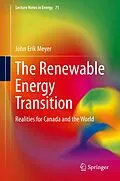Canada is a well-endowed country that serves as an ideal model to lead the reader through the development of energy, resources, and society historically and into a post-carbon future. The book provides an historical perspective and describes the physical resource limitations, energy budgets, and climate realities that will determine the potential for any transition to renewable energy. Political and social realities, including jurisdiction and energy equality issues, are addressed. However, we cannot simply mandate or legislate policies according to social and political aspirations. Policies must comply with the realities of physical laws, such as the energy return on investment (EROI) for fossil-fuel based and renewable energy systems. EROI is discussed in both historical terms and in reference to the greater efficiencies inherent in a distributed generation, mainly electric, post-carbon society. Meyer explores the often misleading concepts and terms that have become embedded in society and tend to dictate our policy making, as well as the language, social and personal goals, and metrics that need to change before the physical transition can begin at the required scale.
This book also reviews what nations have been doing thus far in terms of renewables, including the successes and failures in Canada and across the globe. Ontario's green energy fiasco, and a comparison of the different circumstances of Norway and Alberta, for example, are covered as part of the author's comparison of a wide range of countries. What are the achievements, plans, and problems that determine how well different countries are positioned to make "the transition"?
The transition path is complex, and the tools we need to develop and the physical infrastructure investments we need to make, are daunting. At some point in time, Canada and Canadians, like all nations, will be living on 100% renewable energy. Whether the social and technological level that endures sees us travelling to the stars, or subsisting at a standard of living more similar to the pre-fossil fuel era, is far from certain.
Autorentext
John Erik Meyer has been circling the issues of per capita resources, social equality and leadership since high school. A BA in Economics and years of working with physical units and dollar accounting and costing systems brought the different abilities of these measurement processes into sharp relief. He is a patent holder and has had a number of articles published in Canada's major newspapers dealing with a range of topics from population, immigration and the environment to the failings of GDP based metrics for social policy formation. He has also presented a paper on Energy Currency at a conference of that name in Split, Croatia. He maintains a site, which focuses on the concept of energy based currency. Mr. Meyer is currently President of the NGO Canadians for a Sustainable Society and owner and designer at a small medium tech manufacturing company. He also dabbles in solar electric and heating systems as well as electric bikes and has designed and built a house which he expects to be (eventually) energy positive. His primary interests are the changes necessary to achieve a sustainable society, population cycles, biophysical economics and the reasons for failed human social structures throughout history.
Inhalt
Energy, Resources, Population and Society - Why we need energy and why we need to develop energy policy
- Energy basics EROI examples as they apply to Canada
- Canada and the Americas
- Canadian Pop 250,000 to 38 million = 150:1
- Americas pop 80 million to 1 billion = 12:1
- This indicates the difference energy and technology has made to the ability of humans to thrive on the more marginal lands (ie Canada).
- How high EROI energy and rich resources were critical to Canada's development
- Canada's Current Energy Reality
- Climate realities what renewables will do and what they won't
- Energy Realities
- Two Trajectories over two different time frames
- Climate mandate
- Fossil fuel decline mandate
- The successes
- The failures
- The marginal
- The promising
- Interviews with politicians associated with Green Energy initiatives (incl. Ontario)
- Decision making the difference between monetary based decisions and energy based decisions.
- High resource per capita countries vs low per capita resource countries
- Canada Compared to the world
- Leading nations how did they do it?
- Rule #1 if you want to be rich, be born rich. Thomas Piketty
- Comparison of National Reports on the Transition to Renewable Energy
- How different countries handled their oil endowments.
- The Metrics of Renewable Energy Understanding what you are counting
- Good answers start with good questions.
- Renewable Energy impacts on the availability of other resources.
- EROI the ultimate national metric
- A core national metric
- EROI - how reliable is it?
- How variable is it for different scales of projects?
- EROI open questions
- EROI What it needs to improve
- My House, Your House. Energy Templates.
- My Community
- On the ground decision making
- Rich and high functioning with ownership
- Poor and low functioning with no ownership
- Solar and Wind Farms
- Energy regions jurisdictions vs existing provincial boundaries
- My Province
- My Country
- The public conversation
- Instruments of mass disinformation metrics designed to promote special interests
- Resistance to change - Victims' rights based media coverage (people protest everything)
- The amount of Renewable energy available
- The Timing of Renewable Energy availability
- Storage costs and critical applications
- The Tax Base of Renewable Energy
- The distribution (and jurisdictions) of renewable energy
- Free market reactions vs strategic government planning. What does a workable balance look like?
- Building with fossil fuels
- Building with renewable energy
<...
